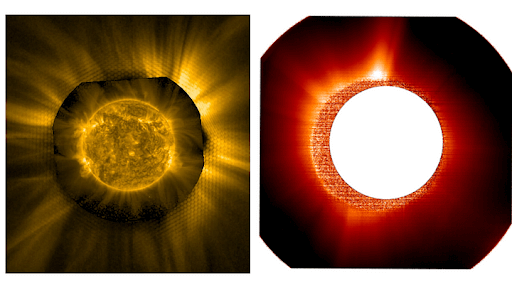A new groundbreaking measurement made by the Solar Orbiter spacecraft and the Parker Solar probe brings scientists closer than ever to solving a longstanding mystery surrounding the sun. Oddly enough, our host star’s atmosphere, or corona, is staggeringly hotter than the solar surface despite being further away from the obvious source of the sun’s heat — and this is a puzzle that has troubled physicists for about 65 years.
The collaboration between these two instruments was made possible when the Solar Orbiter, operated by the European Space Agency (ESA) performed some space-based gymnastics. These maneuvers allowed the spacecraft to observe the sun and NASA’s Parker Solar Probe at the same time. Ultimately, that allowed for simultaneous solar observations between the two, which together indicated that turbulence is likely heating the solar corona to incredible temperatures.
“The ability to use both Solar Orbiter and Parker Solar Probe has really opened up an entirely new dimension in this research,” Gary Zank, co-author of a study on the results and a researcher at the University of Alabama in Huntsville, said in a statement.
This team-up could finally solve the so-called “coronal heating mystery,” which revolves around that heat discrepancy between the corona, made of wispy and nebulous electrically charged gas called plasma, and the sun’s surface, or photosphere.
Related: Scientists may finally know why the sun’s outer atmosphere is so freakishly hot
What is the coronal heating mystery?
The corona can reach temperatures as great as 1.8 million degrees Fahrenheit (1,000,000 degrees Celsius), while 1,000 miles below it, the photosphere only reaches temperatures of around 10,800 degrees Fahrenheit (6,000 degrees Celsius).
That is a troubling fact because the sun’s core, where the nuclear fusion of hydrogen to helium occurs, is where the vast majority of the sun’s heat comes from. This is like air about one foot above a campfire being hotter than air one inch away from the flames.
The discrepancy in heat also means there must be another heating mechanism at play directly on the corona. Until now, that mechanism has evaded scientists, but turbulence in the atmosphere of the sun significantly heating coronal plasma has long been considered a plausible explanation. However, that hypothesis had been impossible to investigate with data from one spacecraft.
Satellites can investigate the sun in two ways: they can get up close and personal, making in-situ measurements like NASA’s Parker Solar Probe does, or they can make more remote investigations like the Solar Orbiter. The Solar Orbiter studies the corona from around 26 million miles (42 million kilometers) away from the sun, while the Parker Solar Probe braves the blazing hot plasma of the sun as it passes around 4 million miles (6.4 million km) from the solar surface.
But, there is a trade-off between the two approaches.
Remote sensing can see broad details about the sun, but suffers when it comes to making observations of what physics is at play in coronal plasma. On the other hand, in-situ observations can measure that plasma in greater detail but tend to miss the bigger solar picture.
That means uniting the large-scale measurements of events on the sun from the Solar Orbiter with the detailed observations of the same phenomenon by the Parker Solar Probe could present us with the total picture of the sun with all intricate details filled in — the best of both worlds.
This isn’t as straightforward as it sounds, however. To facilitate this team-up, the Parker Solar Probe would have to be within the field of view of one of the Solar Orbiter’s instruments as the two observe the sun from their relative positions.
How scientists achieved the ‘best of both worlds’ to potentially solve a solar mystery
A team of astronomers, including Italian National Institute for Astrophysics (INAF) researcher Daniele Telloni, discovered that on June 1, 2022, the two solar observatories would be within touching distance of the desired orbital configuration to engage in such a team-up.
As the Solar Orbiter would be looking at the sun, the Parker Solar Probe would be just off to the side, only a little bit out of view of the ESA spacecraft’s Metis instrument — a device called a “coronagraph” that blocks out light from the photosphere to image the corona and is ideal for large-scale, distant observations.
To perfectly line up the two spacecraft and get the Parker Solar Probe in view of Metis, the Solar Orbiter performed a 45-degree roll and was then pointed slightly away from the sun.
The data that was collected as a result of this well-planned maneuver authorized by the spacecraft’s operation team paid off, revealing turbulence that could indeed be transferring energy in the way solar physicists had theoretically predicted would be causing coronal heating.
The turbulence drives coronal heating in a way that is similar to what happens when coffee is stirred here on Earth. Energy is transferred to smaller scales by random movements in a fluid or gas — coffee and plasma — and this converts that energy to heat. In the case of the corona, plasma is magnetized, and that means stored magnetic energy can also be converted to heat.
The transfer of magnetic and movement or kinetic energy from larger to smaller scales is the very essence of this turbulence, and at the smallest scales, it allows the fluctuations to interact with individual particles, mostly positively charged protons, heating them.
That isn’t to say the mystery of coronal heating is “case closed,” however. Solar scientists still need to confirm the mechanism that has been hinted at by these results and by the collaboration between the Parker Solar Probe and the Solar Orbiter.
“This is a scientific first. This work represents a significant step forward in solving the coronal heating problem,” Solar Orbiter Project Scientist Daniel Müller said.
The team’s research was published on Thursday (Sept. 14) in the Astrophysical Journal Letters.

